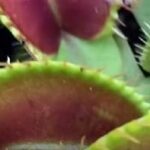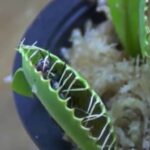As an Amazon Associate, this site earns commissions from qualifying purchases. For more details, click here.
Your Venus flytrap looks fine and healthy, but on closer inspection you see that one of its new growths has turned black. It is all right for old traps to blacken and die, but new growth has to be green. So what could be going on here?
It is normal for old traps to turn black before dying. But if new Venus flytrap growth turns black, it could be due to overwatering, lack of sunlight or fertilized soil. It could also be the results of a stressful environment.
Understanding Venus Flytrap Growth
The traps on Venus flytraps blacken for many reasons. A change in environment, age, repotting, overwatering, overfeeding and amount of light received are among the possibilities.
But not all of these are applicable to new growth. Traps turn black as they age and eventually die. That is normal and to be expected. A new trap will take its place.
But what if this happens to young, new growth? Obviously it cannot be due to aging. Let us look at other reasons and what you can do about it.
Overwatering
Because Venus flytraps need a lot of water, there is a tendency for many to overdo it. Too much water is not good for the plant and could turn traps black and rot.
A clear example of this would be a trap that is mostly black at the top. This usually happens when you water Venus flytraps from the top. Too much of it drenches the traps, and the upper part blackens.
In this instances several traps turn black, including old and new growth. Usually this occurs during summer as that is when Venus flytraps get watered the most.
Venus flytraps reach their peak during this season, so black new growths looks alarming. And if this is not resolved, the rest of the plant could be affected.
Solution
Do not overwater your Venus flytrap because it is harmful. By using the right amount – and right type – of water you can prevent growth blackening.
Keep the soil moist at all times, but not so much water pools on the surface. It is less about how often you should water but more on maintaining soil moisture. Never let the soil dry because it will have a negative effect on Venus flytraps.
The best choice is purified water. Tap water contains mineral deposits that could damage Venus flytraps and cause blackening.
Watering from the top is acceptable, but you have to be careful not to overdo it. A better option is to place your Venus flytrap pot in a container with an inch of water. The drainage holes in the pot will soak the water, so you just need to refill it.
Too Much Food
Feeding too much to your traps can kill its leaves. This can affect old traps and new growths alike, so you need to do this properly.
A big misconception about Venus flytraps is they can eat anything and that you can feed all the traps. Both are not true. Venus flytraps cannot eat human food for instance and you should not feed more than two traps. In fact most cultivators feed just one trap at a time.
If you watch movies you would think Venus flytraps can eat several prey in seconds. The truth is each trap takes days or weeks to finish one meal.
A Venus flytrap needs at least five days to digest an ant, and it might take a week or two to finish larger prey like crickets. Feeding large volumes of food to a trap will cause to turn black and even kill it.
Solution
The simplest solution is to leave your Venus flytrap on an open window. Its traps will catch bugs on its own and no longer require any feeding. All you need to do is water the plant, but you do not have to give it any more nutrients.
Growth turns black if it is overfed or is trying to digest large amounts of food. Feed only one trap and the amount should be only 2/3 or 1/3 the size of the trap.
Venus flytraps only need 3-5 insects a month to satisfy their nutrient quota. But if you feel it is not catching enough, you can give them freeze dried mealworms. They provide the nutrients Venus flytraps need.
Whether you feed the tap dead bugs or freeze dried food, do not fill the trap. The food should be about two thirds or one third the trap size. It seems small but that is a lot for Venus flytraps to digest.
Wrong Soil Mix
Never use regular potting soil. Never use soil with the words “enhanced” or “rich” on the label. Those are great for typical houseplants but not for Venus flytraps. This applies to other carnivorous plants too.
Fertilized soil will do more than just blacken new growth. It weakens the plant and makes it susceptible to root rot and other diseases. Fertilizers that benefit other plants harm Venus flytraps and make it impossible for them to grow traps. Nitrogen pollution is bad for Venus flytraps too.
Solution
Venus flytraps will die if you use fertilized soil. Nutrient free soil like 1:1 peat moss and perlite is perfect. Let the plant get its nutrients from insects instead.
To grow Venus flytraps successfully, you have to simulate its natural habitat. Since they only grow in nutrition free soil, that is what you must provide.
Aside from peat moss and perlite, you can also use silica sand and long fiber sphagnum moss. Add plenty of water to the mixture. Once the soil is ready you can place your Venus flytrap in it.
Use the same soil mixture when repotting to avoid stressing the plant. This will reduce the chances of any traps turning black.
Stressful Environment
Venus flytraps need a healthy, stable environment to grow in. Moving it to a new location or repotting might stress the plant and affect its ability to produce healthy traps.
Suppose your Venus flytrap has been in the same window porch for years, then you move it elsewhere. This can cause a shock to its system as the amount of sunlight it receives will change. The temperature, air resistance, the type of prey available, etc. all these will change.
Healthy Venus flytraps can live a long time, but they need to be in the right environment. If you suddenly change its location and see growth turn black, this could be the reason.
Solution
The best solution is to just wait it out. Assuming the new location gets plenty of light and the plant still gets nutrients and water, it will be fine. Yes you might see a trap or two turn black and die. But these will be replaced by new healthy growth.
When you repot a Venus flytrap especially after it comes out of dormancy, it will take some time for the plant to adjust. It is getting used to receiving sunlight again and naturally, some of its traps will not flourish at first. But give it time.
The same thing applies if you move the plant to another location in your house, even more so if you moved to another home. These plants are sensitive to light, and changes in location affects the type of prey it can catch unless you feed it.
The good news is most Venus flytraps can and do adapt. It might take a few days or weeks, but eventually new green growths will replace the black ones.
If this does not happen, then check any of the possible reasons given above. If you fix those you will see an end to these black growths.
Conclusion
Seeing a blackened trap here and there is nothing to worry about. However you need to take action if new growth does not appear healthy. But if you catch it early enough, you can prevent any harm coming to the rest of your Venus flytrap.

My fascination with carnivorous plants began many, many years ago with Venus Fly Traps. Now I am more than happy to impart what I know with other enthusiasts and those who are curious about meat eating plants.



